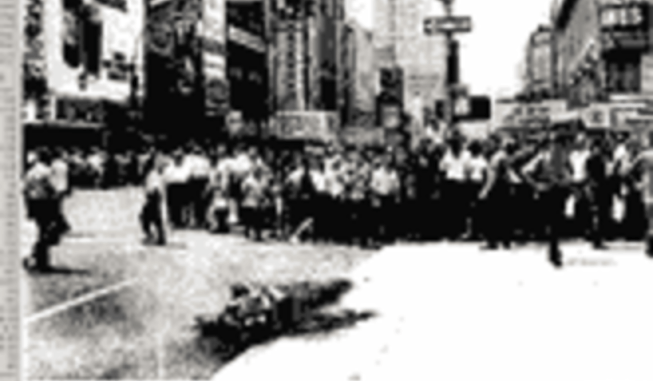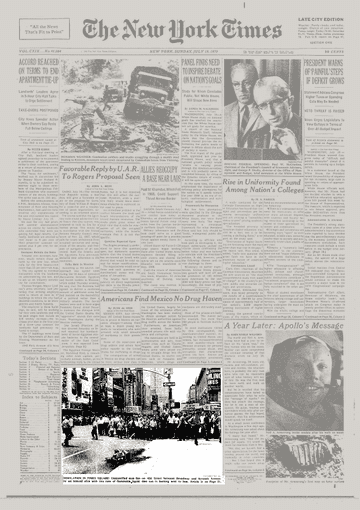
About the Archive
This is a digitized version of an article from The Times’s print archive, before the start of online publication in 1996. To preserve these articles as they originally appeared, The Times does not alter, edit or update them.
Occasionally the digitization process introduces transcription errors or other problems; we are continuing to work to improve these archived versions.

Man Immolates Himself in Times Sq.
By Richard Severo
July 19, 1970
An unidentified man quietly sat down on a curb in crowded Times Square at about 2 P.M. yesterday, poured two cans of a highly flammable liquid over his body, struck a match and burned himself to death.
The self ‐ immolation took place on the north side of 42d Street between Broadway and Seventh Avenue, near the Al lied Chemical Tower. It is one of the busiest places in Man hattan, but apparently no one among the hundreds of pass ers‐by fully realized what was happening until it was too late. Some who saw the flames ig nored them at first.
“I thought it was just an other one of those fires in rubbish basket,” said David Whitmore of 180 First Avenue, who was about 200 feet away on the northeast corner of 42d Street and Seventh Avenue when the flames shot up, ac companied by thick, black smoke.
A White Man About 30
All that the police could de termine immediately was that the victim was a white male about 30 years old. There was no immediate indication of a motive, political or otherwise.
Passers‐by who said they witnessed the burning gave conflicting accounts of what they saw. At first, the victim was variously identified as man and a woman; black, white and oriental, and ranging in age from 18 to 35.
The fuel used by the man was not immediately known. But the heat from the flames caused the black asphalt on 42d Street to melt and run. After the body was removed, all that could he seen were what appeared to be charred bits of newspaper, two subway tokens, a quarter, a dime, four pennies, a nickel and two other coins that were burnt so badly that they could not be recog nized.
Too Late for a Rescue
“I saw him before he burned,” said 19‐year‐old Can dido Gonzalez of 346 West 36th Street. “I walked right by him and he said something like ‘I got enough’ or some thing like that. Then the next thing I know the guy starts throwing gas over his body. He is sitting on the curb throw ing gas and he lights a match. Some guy ran up, I think he was trying to put it out, but nobody could do anything.”
“I saw him, too,” said Robert Malcolm, 17, of Red Bank, N.J., who was in New York for the day, as were so many others in Times Square. “I remember a half‐hour before the fire that I saw him shrug his shoulders, the way New Yorkers do some times.”
Mr. Malcolm said he saw the man pour something over him “but I thought it was water.”
E. Robert Miller, a visitor from Stuart, Fla., said he ran over to the burned man. “But I could see he was dead. There was nothing I could do.”
A few women onlookers screamed when the man began to burn. Only Mr. Malcolm said that he thought that the man might have made a sound while burning. The others said the man remained silent.
Suicide by self‐immolation has not been uncommon in recent years. It has been espe cially prevalent among the Bud dhist monks of Saigon, who have used it to protest govern ment policies and the war.
But self‐immolation has oc curred in this country on sev eral occasions. On May 30, 1969, a 20‐year‐old Columbia student, Bruce Mayrock of Old Westbury, L. I., set himself on fire on the lawn of the United Nations before hundreds of on lookers and died a few hours later. According to a sign he left behind, he was protesting “genocide” in Biafra.
READ ALSO: IMMORTALIZING BRUCE MAYROCK WHO SET HIMSELF ABLAZE IN FRONT OF UNITED NATIONS FOR THE SAKE OF BIAFRA
